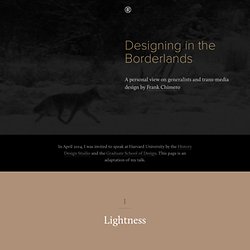

Learner-Centered Teaching: Good Places to Begin. May 15, 2013 By: Maryellen Weimer, PhD in Teaching Professor Blog It’s probably the question I’m most asked in workshops on learner-centered teaching.

In Lieu of Early Decision, a Plan to Date Colleges 'Before I Pop the Big Question' Last time, I gave you an image of summer drawing away from Seattle.

However, we’re in this between-seasons time, so weather is just a pain to deal with. It’s just that it’s cold and rainy in the mornings, and really sunny in the afternoons. Today, we had our first rain since summer began, but it only lasted long enough for me to go up to my apartment, grab an umbrella, and come all the way back down again. Pop Goes the Culture. Ken Myers grew up in a conservative Christian household in Beltsville, Maryland, during the 1960s.

When he was in tenth grade, two important things happened to him. Ken Myers Malcolm Hughes His high school music teacher introduced him to the music of Bach, taking eight months to teach Myers and the rest of the boys’ choir how to sing the motet Jesu, meine Freude. And he fell upon a copy of the Saturday Review. Saturday Review is pretty much forgotten today. “Everyone else in high school was discovering recreational drugs,” Myers told me not long ago. Doctors dump health insurance plans, charge patients less. WICHITA, Kan., June 14 (UPI) -- A Kansas physician says he makes the same income and offers better quality care to his patients after he dumped all health insurance companies.

Thirty-two-year old family physician Doug Nunamaker of Wichita, Kan., said after five years of dealing with the red tape of health insurance companies and the high overhead for the staff he hired just to deal with paperwork, he switched to a system of charging his patients a monthly fee plus the price of an office visit or test, CNN/Money reported. For example, under Nunamaker's membership plan -- also known as "concierge" medicine or "direct primary care" practices -- each patient pays a flat monthly fee to have unlimited access to the doctors and any medical service they can provide in the practice, such as stitches or an EKG.
For adults up to age 44, Nunamaker charges $50 a month, pediatric services are $10 a month, and for adults age 44 and older it costs $100 a month. Apple's Secret Plan to Steal Your Doctor's Heart. Afshad Mistri in 2005 -- before he joined Apple and before the arrival of the iPad (Photo: Frederic Larson/San Francisco Chronicle) Nancy Luo didn’t expect an answer when she e-mailed Steve Jobs one Wednesday evening two summers ago.

But less than a day later, an Apple emissary knocked on her door at the University of Chicago Hospitals. It was Aug. 25, 2010, the last day of a long heatwave in Chicago. Luo — a second-year resident at the hospital’s internal medicine department — had been assigned the tricky task of figuring out whether a pilot program that put iPads in the hands of the hospital’s residents was working out. So she sent a note to the CEO of Apple. The iPad had hit the market just four months earlier, but the young, tech-savvy residents at the hospital were already using Apple’s tablet to access medical data on the go. The Secret Behind America's Best Hoodie? A Design Process Worthy of Apple. American Giant is the maker of the internet's favorite hoodie. This is Anne Palmer, American Giant's Assistant Merchandising Manager, holds up their newest product, the varsity jacket.
American Giant Steve Mootoo, American Giant's technical design director, looks at the fit of the full-zip hoodie. Image: American Giant. Designing in the Borderlands by Frank Chimero. A personal view on generalists and trans-media design by Frank Chimero In April 2014, I was invited to speak at Harvard University by the History Design Studio and the Graduate School of Design.

Attention and Information – The Aporetic. People often argue that we have too much information and too little attention; that this is a condition of being “modern.”

But the opposite may be true: that attention is a human constant and that it constantly seeks new forms. Where there’s “surplus attention” we always come up with things to occupy it. Was the past simpler, with less information to distract the mind and less to worry about? That can’t really be true: there’s nothing simple about farming and the natural world is full of information we’ve lost the capacity to discern.
Here’s an image of pastoral life, taken early in the twentieth century in North Dakota. Rustic simplicity, except that the farmer in charge has labor management problems–who are these workers, how is he compensating them? The Information Sage.